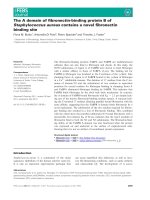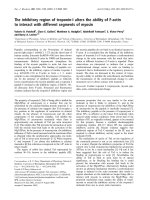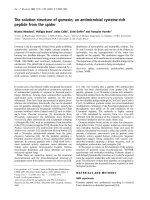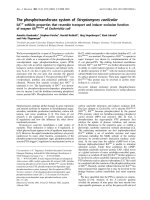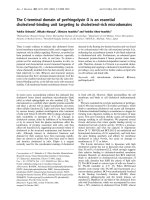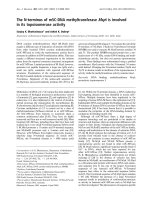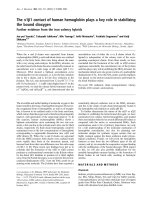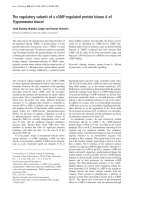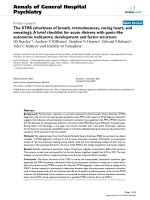Báo cáo Y học: The C-terminal domain of perfringolysin O is an essential cholesterol-binding unit targeting to cholesterol-rich microdomains pptx
Bạn đang xem bản rút gọn của tài liệu. Xem và tải ngay bản đầy đủ của tài liệu tại đây (241.73 KB, 9 trang )
The C-terminal domain of perfringolysin O is an essential
cholesterol-binding unit targeting to cholesterol-rich microdomains
Yukiko Shimada
1
, Mikako Maruya
2
, Shintaro Iwashita
3
and Yoshiko Ohno-Iwashita
1
1
Biomembrane Research Group, Tokyo Metropolitan Institute of Gerontology;
2
Department of Cell Biology, Tokyo Metropolitan
Institute of Medical Science;
3
Mitsubishi Kagaku Institute of Life Sciences (MITILS), Machida, Tokyo, Japan
There is much evidence to indicate that cholesterol forms
lateral membrane microdomains (rafts), and to suggest their
important role in cellular signaling. However, no probe has
been produced to analyze cholesterol behavior, especially
cholesterol movement in rafts, in real time. To obtain a
potent tool for analyzing cholesterol dynamics in rafts, we
prepared and characterized several truncated fragments of
h-toxin (perfringolysin O), a cholesterol-binding cytolysin,
whose chemically modified form has been recently shown to
bind selectively to rafts. BIAcore and structural analyses
demonstrate that the C-terminal domain (domain 4) of the
toxin is the smallest functional unit that has the same cho-
lesterol-binding activity as the full-size toxin with structural
stability. Cell membrane-bound recombinant domain 4 was
detected in the floating low-density fractions and was found
to be cofractionated with the raft-associated protein Lck,
indicating that recombinant domain 4 also binds selectively
to cholesterol-rich rafts. Furthermore, an enhanced green
fluorescent protein-
1
domain 4 fusion protein stains mem-
brane surfaces in a cholesterol-dependent manner in living
cells. Therefore, domain 4 of h-toxin is an essential choles-
terol-binding unit targeting to cholesterol in membrane rafts,
providing a very useful tool for further studies on lipid rafts
on cell surfaces and inside cells.
Keywords: raft; microdomain; cholesterol; BIAcore;
perfringolysin O.
In recent years, accumulating evidence has indicated that
cholesterol forms lateral membrane microdomains (lipid
rafts) in which sphingolipids are also enriched [1,2]. This
microdomain is a scaffold where specific proteins assemble
and plays a pivotal role in signal transduction and many
other cellular functions [3]. Lipid rafts have been isolated
by sucrose density gradient centrifugation after treatment
of cells with Triton X-100 (TX-100) by taking advantage of
their insolubility in detergent at 4 °C [2]. Changes in
cholesterol content, either by inhibition of its biosynthesis
or by its removal from the plasma membrane, affect the
localization of proteins associated with rafts, and thus
affect raft function [4,5], suggesting (an) essential role(s) of
cholesterol in the structural maintenance and function of
rafts. Although interest in cholesterol functions and
demand for their analyses have been increasing rapidly,
there are almost no probes that have been used to detect
and monitor cholesterol in rafts. Filipin is a reagent
currently used for the cytochemical staining of cholesterol
in fixed cells [6]. However, filipin permeabilizes the cell
membrane and binds to cell cholesterol indiscriminately
[6,7].
We have examined the cytolytic mechanism of perfringo-
lysin O (h-toxin) secreted by Clostridium perfringens,which
binds to membrane cholesterol and causes cell disruption.
Cholesterol-mediated binding to a membrane is a trigger for
forming toxin oligomers, leading to the formation of large
pores. This pore formation directly causes cell membrane
damage resulting in cell disruption. We prepared several
h-toxin derivatives that retain specific binding activity to
cholesterol but lack cytolytic activity. Ch [8] is a protease-
nicked derivative and loses the capacity to oligomerize
below 20 °C. MCh [9] and BCh [10,11] are methylated and
biotinylated derivatives of Ch, respectively, and both have
the same binding specificity and affinity for membrane
cholesterol as intact h-toxin, but cause no damage to
membranes at 37 °Corbelow.
The h-toxin derivatives bind to liposomes with high
cholesterol content but not to liposomes that contain less
than 20 mol% of cholesterol [12], which strongly suggests
their selective binding to cholesterol-enriched membrane
domains. Recently we demonstrated that BCh selectively
binds to cholesterol in cholesterol-rich microdomains of
intact cells, domains that fulfill the criteria of lipid rafts
[7]. The BCh bound to various types of cells was found to
be TX-100 insoluble at 4 °C[7].WhenBCh-bound
platelets were treated with TX-100 and fractionated on a
sucrose-density gradient, BCh was predominantly localized
in the floating low-density fractions (FLDF) where
cholesterol, sphingomyelin and Src family kinases are
enriched [7]. Depletion of one-third of the cholesterol from
cells with b-cyclodextrin, which was accompanied by more
than a 70% reduction in cholesterol from FLDF, almost
Correspondence to Y. Shimada or Y. Ohno-Iwashita, Biomembrane
Research Group, Tokyo Metropolitan Institute of Gerontology,
35–2 Sakae-cho, Itabashi-ku, Tokyo 173–0015, Japan.
Fax: +81 3 35794776, Tel: +81 3 39643241 ext. 3063 or 3068,
E-mail: or
Abbreviations: Br-DSPC, brominated distearoylphosphatidylcholine;
DOPC, dioleoylphosphatidylcholine; DSPC, distearoylphospha-
tidylcholine; EGFP, enhanced green fluorescent protein; FLDF,
floating low-density fractions; IPTG, isopropyl thio-b-
D
-galactoside;
2OHpbCD, 2-hydroxypropyl-b-cyclodextrin; PE, phosphatidyl-
ethanolamine; TX-100, Triton X-100.
(Received 5 August 2002, revised 10 October 2002,
accepted 30 October 2002)
Eur. J. Biochem. 269, 6195–6203 (2002) Ó FEBS 2002 doi:10.1046/j.1432-1033.2002.03338.x
completely abolished BCh binding to lipid rafts. This
indicates that the binding of BCh to lipid rafts depends on
their cholesterol content. BCh, coupled with fluorescent-
avidin or colloidal gold-avidin, has been used as a probe
to analyze the distribution of membrane cholesterol by
fluorescence microscopy and electron microscopy
[10,11,13].
Rafts are abundant at the plasma membrane surface, and
are also found in intracellular compartments in the endo-
cytic pathway [14]. In a further study on lipid rafts, analysis
of the dynamic movement of intracellular rafts, for instance
raft assembly and raft trafficking, is necessary as well as that
on the membrane surface. However, as staining with BCh
requires fluorescent avidin, it is not suitable for real-time
imaging of the dynamic movement of lipid rafts in living
cells. Especially, such movement inside the cell is hard to
trace by the indirect fluorescence method. To establish a
system for real-time imaging of rafts, we have attempted to
isolate the cholesterol-binding domain of the toxin. Based
on the 3D crystal structure [15], h-toxin comprises four
b-sheet-rich domains, and only domain 4, located at the
C-terminus, is structurally autonomous [15]. There is
evidence to suggest that a cholesterol-binding site is located
within domain 4. For example, a C-terminal fragment
obtained by trypsin digestion (T2), including predominantly
domain 4, binds to cholesterol and to cholesterol-containing
membranes [16]. Furthermore, experiments with many
toxins mutated in the tryptophan-rich motif at the C-
terminus have revealed a significant reduction in the
membrane-binding activity [17]. However, the cholesterol-
binding site of h-toxin has not been clearly defined as yet.
We have characterized cholesterol binding activity in
relation to toxin stability and identified the smallest region
necessary for its activity. In this paper, we show that
domain 4 of h-toxin is an essential cholesterol-binding unit
targeting to cholesterol in lipid rafts. Furthermore, we
demonstrate that enhanced green fluorescent protein
(EGFP)-tagged domain 4 may be a promising tool for
analyzing raft dynamics in living cells.
EXPERIMENTAL PROCEDURES
Materials
Anti-h-toxin antibody was raised in rabbits as described
previously [16]. A rabbit antibody specific to the C-terminus
of h-toxin was produced using the peptide antigen
CGTTLYPGSSITYN (amino acids C449-N472 of the
mature form of h-toxin). Cholesterol and isopropyl thio-b-
D
-galactoside (IPTG) were purchased from Sigma (St Louis,
MO, USA). Hydroxylapatite was from Seikagaku (Tokyo,
Japan). Peroxidase-conjugated anti-rabbit IgG was pur-
chased from Medical & Biological Laboratories (Nagoya,
Japan). BIAcore sensor chip SA was from BIAcore
(Uppsala, Sweden). Alexa Fluor
TM
546 was from Molecular
Probes, Inc. (Eugene, OR, USA).
Plasmid construction
Plasmid pNSP10 containing the perfringolysin O gene
(pfoA) [17] was used to construct pfoA derivatives encoding
the C-terminal region of the toxin. The DNA fragment
containing the T2¢ (V337-N472)-encoding region was pre-
pared by digesting pNSP10 with SpeIandXhoIand
inserting it between the NheIandXhoIsitesonthe3¢ side of
the sequence encoding His-tag and a thrombin-cleavage site
in the expression vector pET-28b. The DNA fragment
containing the D4 (K363-N472)- or DN-D4 (S371-N472)-
encoding region was amplified from pNSP10 by a poly-
merase chain reaction and ligated into pET-28b digested
with NheIandXhoI. The NheI restriction sites of the
polymerase chain reaction-amplified products were created
as noncomplementary ends of the amplification primers.
For DC-D4 (K363-T470), a pNSP10-derived plasmid enco-
ding D471 (K1-T470) was used as a PCR template. The poly-
merase chain reaction primers used were 5¢-CTCAGGC
TAGCAAGGGAAAAATAAACTTAGATC-3¢ (for D4
and DC-D4), 5¢-TCAGAGCTAGCAGTGGAGCCTATG
TTGCACAG-3¢ (for DN-D4) and 5¢-TGGTGGTGG
TGCTCGAGTGC-3¢. For the construction of a plasmid
encoding a His-tag-EGFP-D4 fusion protein, a DNA frag-
ment containing the EGFP-encoding region was amplified
from pEGFP-N3 (Clontech) by the polymerase chain
reaction with forward primer A (5¢-CGTTCTAGAGT
GAGCAAGGGCGAGGAGCTG-3¢) and reverse primer
B(5¢-ATCTACGTCGGCTAGCCTTGTACAGCTCGT
CCATGCCGAG-3¢). The fragment was then ligated into
the NheI site of the plasmid encoding His-tag-D4. The
DNA sequences in the resulting plasmids were confirmed
by the dideoxynucleotide chain-termination method [18].
Plasmids were introduced into E. coli strain BL21 (DE3)
[19] (Novagen, Madison, WI, USA) by transformation of
competent cells.
Protein production and purification
E. coli strain BL21(DE3) was used for the overexpression of
His-tag-T2¢, His-tag-D4, His-tag-DN-D4 and His-tag-DC-
D4 fusion proteins. After induction with IPTG, E. coli cells
were harvested by centrifugation and lysed in native lysis
buffer (50 m
M
phosphate buffer, pH 8.0, 300 m
M
NaCl,
10 m
M
imidazole) by ultrasonication. The overexpressed
proteins were partially purified from the cytoplasmic
fraction of E. coli by Ni
+
-NTA agarose column chroma-
tography. His-tagged toxin fragments bound to Ni
+
-NTA
agarose were eluted with 250 m
M
imidazole. For further
purification, the fractions containing His-tagged toxin
fragments were loaded onto a hydroxylapatite column
equilibrated with 20 m
M
phosphate buffer, pH 8.0, and the
flow through fraction was collected. Active fragments were
recovered in the flow through fraction, while inactive ones
were adsorbed to hydroxylapatite. The pooled fraction was
incubated with thrombin at an enzyme to substrate ratio of
1 : 100 for 5 h at room temperature to cleave the His-tag
and the cleavage reaction was stopped by the addition of
1m
M
phenylmethanesulfonyl fluoride. After protease treat-
ment, the pooled fraction was applied to a butyl-agarose
column equilibrated with 20 m
M
Tris/HCl, pH 7.5, con-
taining 0.8
M
(NH
4
)
2
SO
4
. The toxin fragments were eluted
with 0.2
M
(NH
4
)
2
SO
4
and dialyzed against Hepes-buffered
saline, pH 7.0, at 4 °C. The purity of the toxin fragments
was checked by SDS/PAGE [20]. The sequence GSHMAS
remains attached to the N termini of purified fragments
after thrombin cleavage. Toxin derivatives MCh and BCh,
and the T2 fragment were prepared as described previously
[9,10,16].
6196 Y. Shimada et al. (Eur. J. Biochem. 269) Ó FEBS 2002
Binding to cholesterol on TLC plates
The cholesterol-binding activity of each toxin fragment was
examined on TLC plates as described previously [16]. Toxin
fragments bound to the TLC plates were detected with anti-
whole h-toxin antibody.
Preparation of lipid vesicles
Phospholipids [dioleoylphosphatidylcholine (DOPC) or
brominated distearoylphosphatidylcholine (Br-DSPC)]
alone or 1 : 1 (mol/mol) mixtures of cholesterol and
phospholipids were evaporated to make lipid films.
Hepes-buffered saline was added to the lipid films and
mixed vigorously. The lipid dispersion was sonicated with a
Branson Sonifier and centrifuged at 9000 g for 5 min to
remove undispersed lipids. For kinetic analysis by the
BIAcore system, 0.1 mol% of biotin-phosphatidylethanol-
amine (PE) was added to the lipid mixture before evapor-
ation. The lipid dispersion containing biotin-PE was frozen
and thawed 10 times, and the resultant multilamellar
vesicles were extruded through 100 nm polycarbonate
membranes in a Liposofast apparatus (Avestin Inc.,
Ottawa, Canada).
Binding of toxin fragments to liposomes and MOLT-4
cells
The toxin fragments were incubated individually with
liposomes in Hepes-buffered saline containing 1 mgÆmL
)1
bovine serum albumin for 30 min at room temperature. The
mixtures were centrifuged at 350 000 g for 30 min at 4 °C.
Both the pellets and the supernatants were analyzed by
Western blotting using anti-C-terminal peptide antibody.
For measurement of binding to cultured cells, MOLT-4
(10
5
cells) [21] were washed twice with phosphate-buffered
saline (NaCl/P
i
), and then incubated with or without 5 m
M
2-hydroxypropyl-b-cyclodextrin (2OHpbCD) in serum-free
RPMI 1640 for 15 min at 37 °C. The cells were then washed
twice with NaCl/P
i
, and then incubated with toxin frag-
ments (0.3 lg) in NaCl/P
i
containing 1 mgÆmL
)1
bovine
serum albumin for 30 min at 37 °C. Toxin fragments bound
to cells were obtained in the pellet by centrifugation.
Measurement of Trp fluorescence
A 0.3 nmol sample of each purified toxin fragment was
mixed with either phospholipid-liposomes [toxin fragment/
phospholipids 1 : 30 (mol/mol)] or cholesterol/phospho-
lipid-liposomes [toxin fragment/cholesterol 1 : 30 (mol/mol)]
in 1.5 mL of Hepes-buffered saline. After incubation for
10 min at room temperature, emission spectra were recor-
ded in the range of 300–400 nm at an excitation wavelength
of 295 nm with a Shimadzu spectrofluorophotometer
RF-5000.
Circular dichroism spectra
Circular dichroism spectra were recorded on a JASCO
J-720 spectropolarimeter with 5 mm pathlength cells. Toxin
fragments in NaCl/P
i
were scanned from 250 to 200 nm.
Molecular ellipticity ([h]) was calculated based on the mean
residue weight of each fragment.
Kinetic analysis of toxin fragments in cholesterol
binding
The cholesterol-binding kinetics of toxin fragments were
determined by surface plasmon resonance [22] using BIA-
core 1000
TM
. All experiments were carried out at 25 °Cin
degassed Hepes-buffered saline. DOPC/cholesterol lipo-
somes containing biotin-PE were injected and immobilized
on a sensor chip SA that has dextran matrix-attached
streptavidin. After immobilization, the final signal increase
was 1000 response units (RU). MCh,T2¢ and D4 were
dialyzed against the same buffer and applied to the
liposome-immobilized sensor chip. Analyses were per-
formed at a flow rate of 20 lLÆmin
)1
. Another sensor chip
SA bearing immobilized DOPC/biotin-PE liposomes was
used as a control.
Susceptibility of toxin fragments to a protease
Liposome-bound toxin fragments were obtained by ultra-
centrifugation after incubation with liposomes as described
above. Subtilisin BPN¢ was mixed with toxin fragment or
liposome-bound toxin fragment preparations in 50 m
M
phosphate buffer, pH 7.0. The mixture was incubated for
30 min at 27 °C and the cleavage reaction was stopped by
the addition of phenylmethanesulfonyl fluoride at a final
concentration of 1 m
M
.
TX-100 treatment and sucrose density gradient
fractionation
In order to isolate TX-100-insoluble membranes, MOLT-4
cells were extracted on ice for 20 min with 1% TX-100 in
TNE buffer (25 m
M
Tris/HCl, pH 7.5, 150 m
M
NaCl,
5m
M
EDTA) containing 2 m
M
phenylmethanesulfonyl
fluoride, 1 m
M
leupeptin, 25 lgÆmL
)1
aprotinin and
20 lgÆmL
)1
soybean trypsin inhibitor. Then the TX-100-
soluble and -insoluble fractions were separated by centri-
fugation at 15 000 g for 15 min and analyzed by Western
blotting. For sucrose density gradient fractionation,
TX-100-treated cells were homogenized with a Potter–
Elvehjem homogenizer and mixed with an equal volume of
80% sucrose, overlaid with 2.4 mL of 35% sucrose and
1.3 mL of 5% sucrose in TNE buffer. After centrifugation
at 250 000 g for 18 h at 4 °C in a SW55 rotor, 11 fractions
of 0.4 mL each were collected from the top and the pellet
was suspended in 0.4 mL of TNE buffer.
Fluorescence microscopy
For fluorescence microscopic observation, EGFP-D4 was
overexpressed in E. coli and purified with Ni
+
-NTA
agarose as described for the purification of the T2¢ and
D4 fragments. The fractions eluted from the Ni
+
-NTA
agarose column were applied to a butyl-agarose column
equilibrated with 20 m
M
Tris/HCl, pH 7.5, containing
0.8
M
(NH
4
)
2
SO
4
. EGFP-D4 was eluted with 20 m
M
Tris/
HCl, pH 7.5. Cells were incubated with EGFP-D4 in
serum-free RPMI-1640 for 5 min at 37 °C. After washing
with RPMI 1640, fluorescence images of living cells were
observed using an Olympus fluorescent microscope. No
significant difference in cell viability was found before and
after EGFP-D4 addition by checking with trypan blue
Ó FEBS 2002 A probe for raft cholesterol in living cells (Eur. J. Biochem. 269) 6197
exclusion. More than 95% of the cells were viable after
being labeled with EGFP-D4, washed and incubated for
one hour at room temperature.
Others
Tricine-SDS/PAGE was performed by the method of
Schagger [23]. N-terminal sequences of toxin fragments
were analyzed with a precise cLC protein sequencer
(Applied Biosystems) according to the manufacturer’s
recommendations.
RESULTS
Isolation of cholesterol-binding fragments of h-toxin
As the C-terminal portion of h-toxin might retain choles-
terol binding activity, several N-terminal truncated frag-
ments were constructed and expressed in E. coli.Toxin
fragments T2¢,D4,DN-D4, and DC-D4 [Fig. 1(A)] were
purified from the cytoplasmic fraction of E. coli by
Ni
+
-NTA agarose, hydroxylapatite and butyl agarose
column chromatographies. We also prepared the T2
fragment [16] and a toxin derivative, MCh [9], from
recombinant h-toxin protein by biochemical modification
as described before. Three fragments (T2, T2¢ and D4) were
obtained as single proteins [Fig. 1(B)]. On the other hand,
DN-D4, which is truncated by eight-amino acids from the N
terminus of domain 4, and DC-D4, which has only two
amino acids deleted from the C terminus of domain 4, were
not stable during the purification process. Therefore small
amounts of the DN-D4 and DC-D4 fragments were
recovered. N-terminal sequence analysis of the T2¢ and
D4 fragments revealed that they have the expected
N-terminal sequence.
Binding specificity and affinity of toxin fragments
for cholesterol
We first examined the binding specificity of the toxin
fragments to cholesterol by immunostaining with anti-h-
toxin antibody on lipid-developed TLC plates. The T2¢ and
D4 fragments, as well as T2 and MCh, bound only to free
cholesterol among lipids [Fig. 2(A)], indicating specific
recognition of free cholesterol by these toxin fragments. To
investigate the binding specificity to cholesterol as a mem-
brane component further, liposomes containing cholesterol
were prepared. After incubation with DOPC/cholesterol
liposomes, the T2¢ and D4 fragments were detected in the
pellet fraction [Fig. 2(B)], which shows that the fragments
have binding activity similar to those of intact h-toxin, MCh
and T2. Negligible amounts of toxin fragments were bound
to liposomes prepared without cholesterol, indicating the
specific binding for cholesterol in membranes. These results
show that cholesterol-binding activity resides in domain 4,
and the binding specificity is the same as that of h-toxin.
They also indicate that the amino acid sequence of whole
domain 4 is required for folding into a stable structure
for cholesterol binding. As expected, neither T2¢ nor D4
showed hemolytic activity (data not shown) despite of their
ability to bind to cholesterol-containing membranes.
We next examined the cholesterol-binding kinetics of
these toxin fragments by surface plasmon resonance using a
sensor chip on which cholesterol-containing liposomes were
immobilized (Table 1). Association and dissociation rate
constants for T2¢ and D4 binding to cholesterol-containing
liposomes were almost the same as corresponding constants
for MCh binding (Table 1), indicating that the deletion of
domains 1–3 from the toxin did not influence the binding
kinetics. As a result, the dissociation constants also exhibit
similar values. These experiments with liposomal mem-
branes show that domain 4 retains the same binding
specificity and binding affinity for membrane cholesterol
as h-toxin.
Protease susceptibility of membrane-bound toxin
fragments
To investigate the state of the toxin fragments during
membrane binding, we analyzed the susceptibilities of the
T2¢ and D4 fragments to protease in the presence and
absence of membranes (Fig. 3). In the absence of liposomal
Fig. 1. Isolation of toxin fragments. (A) Schematic drawings of h-toxin
and its derivatives. Recombinant toxin fragments T2¢,D4,DN-D4 and
DC-D4 were produced in E. coli with an N-terminal His-tag for
purification. After thrombin digestion, an extra of six amino acids
remained at the N terminus of each fragment (dotted rectangles). T2 is
a tryptic fragment of h-toxin and the N-terminal sequence was deter-
mined previously [8]. Amino acid numbers shown in each toxin
derivative correspond to the positions in h-toxin. The black rectangles
represent the tryptophan-rich motif in domain 4. The arrowhead
indicates the position of a protease-nicked site located between T144
and H145 in MCh and BCh. (B) SDS/PAGE of purified toxin frag-
ments and derivatives. Toxin fragments (T2¢ and D4) were expressed in
E. coli and purified from the cytoplasmic fraction by a series of column
chromatographies as described in Experimental procedures. MCh and
T2 were obtained from recombinant h-toxin by biochemical modifi-
cations as described before. Lane M shows molecular size marker
proteins.
6198 Y. Shimada et al. (Eur. J. Biochem. 269) Ó FEBS 2002
membranes, both fragments were digested by subtilisin
BPN¢ into undetectable pieces (Fig. 3, lanes 2 and 6). When
the D4 fragment bound to DOPC/cholesterol liposomes
was treated with subtilisin BPN¢, no changes in fragment
size were observed on Tricine-SDS/PAGE (Fig. 3, lane 8).
In the case of T2¢, after binding to DOPC/cholesterol
liposomes, subtilisin BPN¢ digestion produced a proteolytic
fragment with a molecular size similar to that of the D4
fragment (Fig. 3, lane 4). The resultant proteolytic frag-
ments were recovered from the gel (lanes 4 and 8) and their
N-terminal sequences were analyzed by a protein sequencer.
The N-terminal amino acid sequence of the liposome-
bound D4 fragment after digestion was found to be
GSHMASKGKI, which corresponds to the N-terminal
sequence of the intact D4 fragment, indicating that no
cleavage occurred. On the other hand, the N-terminal
amino acid sequence of the digested product of the
liposome-bound T2¢ fragment was determined to be STE-
YSKGKIN, indicating that 27 amino acid residues were
cleaved from the N terminus of T2¢. The cleaved position is
shown in the 3D structure of the T2¢ fragment (Fig. 3),
demonstrating that the entire domain 4 region is protected
from protease digestion. This finding is consistent with the
Fig. 2. Binding of h-toxin fragments to cholesterol. (A) Specific binding
of h-toxin fragments to cholesterol on TLC plates. Lipid mixtures
containing 2 lg each of standard neutral lipids were applied to TLC
plates and the plates were developed. The plates were then incubated
with toxin fragments or derivatives and bound proteins were detected
by immunostaining with anti-(whole h-toxin) Ig. Lipids were detected
with 3% cupric acetate/8% phosphoric acid by heating at 140 °C
(ÔlipidsÕ lane). PC, phosphatidylcholine; SM, sphingomyelin. (B) Toxin
binding to liposomal membranes. h-Toxin, MCh and toxin fragments
were incubated with DOPC liposomes or DOPC/cholesterol liposomes
for 20 min at room temperature. After centrifugation, the total frac-
tion (T), and the resulting supernatant (S) and pellet (P) fractions were
separated and analyzed by SDS/PAGE followed by immunoblotting
with an antibody against h-toxin C-terminal peptide. Lane M shows
molecular size marker proteins.
Table 1. Kinetic analysis of toxin fragment binding to cholesterol by surface plasmon resonance. Kinetic analysis of toxin fragment binding to
immobilized cholesterol-containing liposomes was performed as described in ÔExperimental proceduresÕ. The binding kinetics were analyzed by the
software
BIAEVALUATION
2.1. Each value is given as mean ± SE, n ¼ 6.
Toxin fragment k
on
(
M
)1
Æs
)1
) k
off
(s
)1
) K
D
(
M
)
D4 (1.1 ± 0.29) · 10
5
(6.0 ± 0.47) · 10
)3
(5.2 ± 0.14) · 10
)8
T2¢ (1.7 ± 0.47) · 10
5
(1.4 ± 0.17) · 10
)2
(8.8 ± 0.30) · 10
)8
MCh (5.1 ± 2.5) · 10
4
(6.5 ± 0.11) · 10
)3
(1.5 ± 0.81) · 10
)7
Fig. 3. Susceptibility of T2¢ and D4 to protease. T2¢ and D4 fragments
were digested with subtilisin BPN¢ in the presence or absence of cho-
lesterol-containing liposomes. After protease treatment, the resultant
fragments were separated by Tricine-SDS/PAGE and analyzed by
Western blotting with an antibody against h-toxin C-terminal peptide.
In the lower panel the 3D structures of T2¢ and D4 are shown in black
against a gray background of the whole h-toxin structure. The arrow
indicates the position of cleavage by the protease in the presence of
cholesterol-containing liposomes. The N-terminal sequences of T2¢
and D4 are also shown in the lower panel.
Ó FEBS 2002 A probe for raft cholesterol in living cells (Eur. J. Biochem. 269) 6199
observation that the resultant fragment was nearly the same
size as the D4 fragment on Tricine-SDS/PAGE. As
liposomes not containing cholesterol do not protect the
fragments against protease digestion (data not shown),
cholesterol-dependent membrane binding is required for
protection.
Tryptophan fluorescence and circular dichroism spectra
of the fragments
To examine the conformation of the toxin fragments that
bind to liposomes, intrinsic tryptophan fluorescence was
measured (Fig. 4). Among seven tryptophan residues in
h-toxin, domain 4 contains six, while only one (Trp137) is
located in the N-terminal region (domain 1). To eliminate
the spectral contribution of Trp137, we used W137F, a
mutant h-toxin in which Trp137 in the N-terminal region is
replaced by Phe [17]. Some tryptophan residues in domain 4,
especially those within the 11-amino acid consensus
sequence (tryptophan-rich motif), insert into the membrane
lipid layer when intact h-toxin binds to the membrane [24].
Upon binding to cholesterol-containing membranes, tryp-
tophan fluorescence in all toxin fragments was markedly
enhanced (Fig. 4, dotted and dashed line), as is observed in
intact h-toxin [25]. Next we examined whether the enhanced
tryptophan fluorescence of the toxin fragments is quenched
by liposomes containing Br-DSPC [24,25], in which bro-
mines were placed on the 9,10-carbon atoms of the acyl
chains. It is known that bromine atoms quench intrinsic
tryptophan fluorescence in their vicinity [26,27]. When T2,
T2¢ and D4 bound to Br-DSPC/cholesterol liposomes, the
tryptophan fluorescence enhanced by binding to cholesterol
was remarkably quenched by Br-DSPC (Fig. 4, long dashed
line), in a similar manner to those of h-toxin and W137F.
Compared to W137F and MCh,themaximalemission
wavelengths of the T2, T2¢ and D4 fragments are distinctly
longer (336–338 vs. 345–346 nm) in the absence of lipo-
somes (Fig. 4, solid line). These results show that the
environment of the tryptophan residues in the T2, T2¢ and
D4 fragments is more exposed to solvent than in the case of
the full-size toxins. However, after binding to cholesterol-
containing liposomes, T2, T2¢ and D4 showed a blue shift in
the maximal emission wavelength resembling that (336 nm)
of intact h-toxin, MCh and W137F (Fig. 4, dotted and
dashed line). These results suggest that the toxin fragments
may change the conformation of their cholesterol-binding
site to that of the full-size toxin, when they bind to
membrane cholesterol.
We also analyzed their secondary structures by circular
dichroism measurement. The D4 fragment is enriched in
b-sheets (data not shown), which is consistent with the
structure predicted from X-ray crystallography, supporting
the idea that biosynthesized domain 4 automatically folds
into the secondary structure of the native toxin. On the
other hand, the spectra of the T2 and T2¢ fragments exhibit
more disordered structures than that of D4. These data
imply that their extra N-terminal sequences other than
domain 4 might be a disordered structure.
Selective binding of D4 to lipid rafts
The binding characteristics of the D4 fragment to intact
cell membranes was examined. The D4 fragment was
detected in the cell fraction after incubation with MOLT-
4 cells (Fig. 5A, )2OHpbCD, pellet fraction). Treatment
with 5 m
M
2OHpbCD for 15 min at 37 °C, which
depletes cholesterol by 30%, caused significant reduction
in the number of D4 fragments bound to MOLT-4 cells
(Fig. 5A, 5 m
M
2OHpbCD), demonstrating cholesterol-
dependent binding. We have previously shown that BCh
binds selectively to lipid rafts in intact platelets [7]. To
analyze the selectivity of binding, we first examined the
detergent-insolubility of the D4 fragment bound to
MOLT-4 cells. After extraction with 1% TX-100 on
ice, the membrane-bound D4 fragment was recovered in
the Triton-insoluble membrane fraction (Fig. 5A, TX).
Next, we examined the distribution of the cell membrane-
bound D4 fragment in sucrose gradient fractionation
following solubilization with TX-100. The D4 fragment
was recovered predominantly in the FLDF where lipid
rafts are known to be located (Fig. 5B). Cholesterol and
a tyrosine kinase, Lck [2,28], were recovered in the same
fractions (Fig. 5B), confirming that these fractions are
enriched in lipid rafts. In parallel experiments, BCh-
bound cells were treated with TX-100 and fractionated
on a sucrose gradient, which showed that the distribution
pattern of D4 is the same as that of BCh (data not
shown). These results show that the D4 fragment binds
selectively to lipid rafts, indicating that the binding
characteristics of BCh targeting to lipid rafts can be
ascribed to domain 4.
Visualization of the probe
To understand the biological function of lipid rafts, it is
necessary to examine the distribution of cell membrane
Fig. 4. Fluorescence emission spectra of toxin fragments and derivatives.
The intrinsic tryptophan fluorescence of toxin fragments and deriva-
tives was examined (solid lines) as described in Experimental proce-
dures. These proteins were incubated with three types of liposomes,
DOPC liposomes (dotted lines), DOPC/cholesterol liposomes (dotted
and dashed lines), and Br-DSPC/cholesterol liposomes (long dashed
lines). After 10 min at room temperature, the fluorescence emission
spectra were measured. Maximal emission wavelengths in the presence
of DOPC/cholesterol liposomes and in the absence of liposomes are
displayed on the graphs in nanometers.
6200 Y. Shimada et al. (Eur. J. Biochem. 269) Ó FEBS 2002
cholesterol in real time. Thus we attempted to visualize
membrane cholesterol using domain 4 directly labeled
with a fluorescent dye in live cells. As domain 4 has no
membrane-damaging activity by itself, it is a good
candidate for the construction of cholesterol-specific
probes. To prepare the fluorescent toxin fragment, the
T2¢ and D4 fragments were labeled with Alexa 546. Alexa-
labeled toxin fragments stained cell surfaces and
2OHpbCD treatment abolished this staining, indicating
cholesterol-specific binding (data not shown). We tried
another approach in which EGFP was fused to the N
terminus of D4. The EGFP-D4 fusion protein was
overproduced in E. coli and purified as described in
ÔExperimental proceduresÕ. Following incubation with
EGFP-D4 for 5 min at room temperature, clear fluores-
cent labeling was observed on the surface of live MOLT-4
cells (Fig. 6A). EGFP-D4 stains cells in a cholesterol-
dependent manner as no staining was observed in
2OHpbCD-treated cells (Fig. 6B). Together with the
finding that the D4 fragment binds selectively to lipid
rafts, EGFP-D4 allows us to visualize membrane choles-
terol in lipid rafts of live cells.
DISCUSSION
To clarify the physiological significance of lipid rafts, many
experimental tools have been used. Bacterial toxins that
target components in rafts are often used as raft markers
[29]. Cholera toxin is used to detect ganglioside GM1, which
is enriched in lipid rafts [30]. Sphingomyelin, a major
component of rafts, is a target for lysenin, which is secreted
by earthworms [31]. However, no tool has been reported for
the detection of cholesterol in lipid rafts in living cells. In this
paper, to obtain a probe for targeting raft cholesterol, we
isolated and characterized the minimal toxin fragment of
h-toxin that binds to cholesterol with the high specificity of
native h-toxin without cytolytic activity. The D4 fragment,
which corresponds to domain 4, retains a stable structure
and has cholesterol-binding activity with high affinity.
As to the structural features of the purified D4 fragment,
the circular dichroism measurements revealed that the
isolated domain 4 exhibits a secondary structure enriched
in b-sheets, in good agreement with that predicted from
crystal structure [15]. However, the maximal emission
wavelength of the intrinsic tryptophan fluorescence is red-
shifted in the D4 fragment (Fig. 4), which indicates that the
environment of the tryptophan residues in the D4 fragment
is more exposed to solvent than in the native toxin. As no
tryptophan is present at the interface of domain 4 with
domains 1–3, the above results imply a structural change
accompanied by the removal of domains 1–3. Therefore,
domain 4 is an autonomous domain, but some co-operation
with domains 1–3 is necessary for folding into the native
tertiary structure. However, it should be noted that this
structural difference does not affect the binding affinity and
specificity of D4 to membrane cholesterol. In addition, upon
binding to cholesterol, the polarity of the local environment
around the tryptophan residues in the D4 fragment becomes
the same as in the intact toxin (Fig. 4), suggesting that
binding to membranes restores the conformation of the D4
fragment to that in the membrane-bound form of the full-
size toxin. This is in striking contrast with some C-terminal
Fig. 5. D4 fragment is enriched in FLDF after binding to membrane
cholesterol. (A) MOLT-4 cells (10
6
cellsÆmL
)1
) treated with (5 m
M
2OHpbCD) or without () 2OHpbCD) 2OHpbCD were incubated
with D4 fragment for 15 min at 37 °C. After centrifugation, the total
fraction (T) and the resultant supernatant (S) and pellet (P) fractions
were analyzed by SDS/PAGE followed by Western blotting with an
anti C-terminal peptide antibody. A portion of the resultant pellet
obtained from the 2OHpbCD untreated sample was extracted with 1%
TX-100 for 20 min on ice and the soluble (TX, S) and insoluble (TX, P)
fractions were separated by centrifugation at 15 000 g.(B)D4frag-
ment-bound MOLT-4 cells were treated with 1% TX-100, homogen-
ized and subjected to a sucrose density gradient centrifugation. Eleven
fractions (starting at the top) and the pellet (P) were collected. The
distributions of D4, Lck and cholesterol were measured.
Fig. 6. Staining of cell surface cholesterol in living cells with EGFP-D4.
(A) MOLT-4 cells were incubated with EGFP-D4 for 5 min at room
temperature. Labeled cells were observed under a fluorescent micro-
scope. (B) MOLT-4 cells were treated with 5 m
M
2OHpbCD to deplete
cholesterol and then stained with EGFP-D4. Left panel, phase con-
trast; right panel, fluorescence.
Ó FEBS 2002 A probe for raft cholesterol in living cells (Eur. J. Biochem. 269) 6201
truncated mutants, in which a similar red shift of tryptophan
fluorescence is accompanied by the complete loss of
cholesterol-binding activity [32]. It is noteworthy that even
a small truncation of domain 4 at either the N or C terminus
causes instability of the products. Especially, the deletion of
only two amino acids from the C terminus might cause
product instability, resulting in little production. Therefore,
we conclude that the D4 fragment, which corresponds to
domain 4, is the smallest cholesterol-binding unit that is
structurally stable. Recently recombinant domain 4 (r-d4)
of streptolysin O was isolated by a combination of TX-100-
extraction, denaturation with urea and ethanol precipitation
[33]. Such drastic procedures might affect the conformation
of native structure. Furthermore, bovine serum albumin
was required for the renaturation of r-d4, resulting in failure
in analysis of the toxin structure. On the other hand, our
procedures for the purification of recombinant domain 4
are under native conditions without the use of any
detergents or denaturants, which makes it possible to
analyze its structure precisely. At present, the amino acid
residues involved in cholesterol binding remain unidentified.
Recombinant domain 4 should provide a good tool for
analyzing cholesterol-binding sites, for instance, by NMR
on the toxin–cholesterol interaction.
The cytolytic activity of h-toxin depends on its oligo-
merization, which leads to pore formation in the cell
membrane. We have previously shown that T2 lacks
oligomerization activity due to the deletion of the
N-terminal portion, resulting in no cytolytic activity [16].
T2¢ and D4, shorter fragments than T2, also lack cytolytic
activity. In this report we demonstrate that the isolated
domain 4 has the ability to recognize and bind to membrane
cholesterol, the first step in h-toxin action. The isolated
domain 4 has a binding affinity for cholesterol similar to
that of the full-size toxin as revealed by surface plasmon
resonance measurement (Table 1). We previously showed
that binding of the toxin to membrane cholesterol triggers
its conformational change around tryptophan residues in
domain 4 [24,25]. Such conformational change occurs
without oligomerization, as a similar change was observed
for isolated T2 fragment (Fig. 4). Recently a model was
proposed that toxin oligomerization triggers the insertion of
a portion of domain 3 as b-hairpins, which contribute to the
formation of a transmembrane pore [34,35]. Although
domain 3 might play a role for pore formation, our results
clearly demonstrated that the insertion of domain 3 is not
required for maintaining the high affinity of the toxin for the
membrane, as revealed by BIAcore analysis (Table 1).
The D4 fragment has selective binding affinity for
cholesterol in lipid rafts (Fig. 5B) as demonstrated with
BCh [7], a protease-nicked and biotinylated full-size h-toxin.
Therefore the selectivity of binding to lipid rafts is ascribed
to domain 4. We also show that EGFP-D4 is a potent
probe for the detection of cell surface cholesterol in live cells.
As most membrane-bound EGFP-D4 was recovered in
FLDF (data not shown), the staining should display the
distribution of cholesterol in membrane rafts. The cell-
staining profile with EGFP-D4 is quite similar to that with
Alexa-labeled D4, suggesting the fusion with EGFP does
not influence the cholesterol-binding activity of D4. Previ-
ously we reported that BCh is a specific probe for the
detection of cholesterol by fluorescent microscopy [10,11].
Cholesterol on the outer surface of the plasma membrane
can be stained with BCh coupled with FITC-conjugated
avidin. On the other hand EGFP-D4 can be used to
visualize cell surface cholesterol in both living and fixed cells
in only one step. Therefore staining with EGFP-D4 has the
advantage that the distribution and movement of choles-
terol in living cells can be monitored without artifacts linked
to the cross-linkage of FITC-conjugated avidin. Further-
more, it is possible to use EGFP-D4 to detect intracellular
distribution of cholesterol. We are now constructing an
expression vector for intracellular EGFP-D4 to analyze the
movement of cholesterol-containing microdomains within
live cells. Thus, the recombinant domain 4 could become a
key tool for investigating the distribution and movement of
not only the membrane surface, but also intracellular
cholesterol in lipid rafts.
ACKNOWLEDGMENTS
We thank Dr Ichiro Yahara for providing facilities of kinetic analysis
by the BIAcore systems. We thank Drs Yoshitaka Nagai and Koichi
Suzuki for support and encouragement. We are grateful to Drs
Inomata and Hayashi for technical advice and to Dr M.M. Dooley-
Ohto for reading the manuscript.
This work was supported by grants from the Japan Science and
Technology Corporation, the Japan Science Society (to Y.S.) and from
a Grant-in-Aid for Scientific Research from the Japan Society for the
Promotion of Science, ONO Medical Research Foundation and Life
Science Foundation of Japan (to Y.O I.). Y.S. is a Domestic Research
Fellow of the Japan Science and Technology Corporation.
REFERENCES
1. Simons, K. & Ikonen, E. (1997) Functional rafts in cell mem-
branes. Nature 387, 569–572.
2. Brown, D.A. & London, E. (2000) Structure and function of
sphingolipid- and cholesterol-rich membrane rafts. J. Biol. Chem.
275, 17221–17224.
3. Simons, K. & Toomre, D. (2000) Lipid rafts and signal trans-
duction. Mol. Cell Biol. 1, 31–39.
4. Hooper, N.M. (1999) Detergent-insoluble glycosphingolipid/
cholesterol-rich membrane domains, lipid rafts and caveolae. Mol.
Membr. Biol. 16, 145–156.
5. Ostermeyer, A.G., Beckrich, B.T., Ivarson, K.A., Grove, K.E. &
Brown, D.A. (1999) Glycosphingolipids are not essential for for-
mation of detergent-resistant membrane rafts in melanoma cells.
methyl-beta-cyclodextrin does not affect cell surface transport of a
GPI-anchored protein. J. Biol. Chem. 274, 34459–34466.
6. Neufeld, E.B., Cooney, A.M., Pitha, J., Dawidowicz, E.A.,
Dwyer, N.K., Pentchev, P.G. & Blanchette-Mackie, E.J. (1996)
Intracellular trafficking of cholesterol monitored with a cyclo-
dextrin. J. Biol. Chem. 271, 21604–21613.
7. Waheed, A.A., Shimada, Y., Heijnen, H.F.G., Nakamura, M.,
Inomata, M., Hayashi, M., Iwashita, S., Slot, J.W. & Ohno-
Iwashita, Y. (2001) Selective binding of perfringolysin O derivative
to cholesterol-rich membrane microdomains (rafts). Proc. Natl
Acad. Sci. USA 98, 4926–4931.
8. Ohno-Iwashita, Y., Iwamoto, M., Mitsui, K., Kawasaki, H. &
Ando, S. (1986) Cold-labile hemolysin produced by limited pro-
teolysis of theta-toxin from Clostridium perfringens. Biochemistry
25, 6048–6053.
9.Ohno-Iwashita,Y.,Iwamoto,M.,Ando,S.,Mitsui,K.&
Iwashita, S. (1990) A modified theta-toxin produced by limited
proteolysis and methylation: a probe for the functional study of
membrane cholesterol. Biochim. Biophys. Acta 1023, 441–448.
10. Iwamoto, M., Morita, I., Fukuda, M., Murota, S., Ando, S. &
Ohno-Iwashita, Y. (1997) A biotinylated perfringolysin O
6202 Y. Shimada et al. (Eur. J. Biochem. 269) Ó FEBS 2002
derivative: a new probe for detection of cell surface cholesterol.
Biochim. Biophys. Acta 1327, 222–230.
11. Fujimoto, T., Hayashi, M., Iwamoto, M. & Ohno-Iwashita, Y.
(1997) Crosslinked plasmalemmal cholesterol is sequestered to
caveolae: analysis with a new cytochemical probe. J. Histochem.
Cytochem. 45, 1197–1205.
12. Ohno-Iwashita, Y., Iwamoto, M., Ando, S. & Iwashita, S. (1992)
Effect of lipidic factors on membrane cholesterol topology – mode
of binding of theta-toxin to cholesterol in liposomes. Biochim.
Biophys. Acta 1109, 81–90.
13. Mobius, W., Ohno-Iwashita, Y., van Donselaar, E.G., Oorschot,
V.M.J., Shimada, Y., Fujimoto, T., Heijnen, H.F.G., Geuze, H.J.
& Slot, J.W. (2002) Immunoelectron microscopic localization of
cholesterol using biotinylated and non-cytolytic perfringolysin O.
J. Histochem. Cytochem. 50, 43–55.
14. Simons, K. & Ikonen, E. (1998) Protein and lipid sorting from the
trans-Golgi network to the plasma membrane in polarized cells.
Semin. Cell Dev. Biol. 5, 503–509.
15. Rossjohn, J., Feil, S.C., McKinstry, W.J., Tweten, R.K. & Parker,
M.W. (1997) Structure of a cholesterol-binding, thiol-activated
cytolysin and a model of its membrane form. Cell 89, 685–692.
16. Iwamoto,M.,Ohno-Iwashita,Y.&Ando,S.(1990)Effectof
isolated C-terminal fragment of theta-toxin (perfringolysin O) on
toxinassemblyandmembranelysis.Eur. J. Biochem. 194, 25–31.
17. Sekino-Suzuki, N., Nakamura, M., Mitsui, K. & Ohno-Iwashita,
Y. (1996) Contribution of individual tryptophan residues to the
structure and activity of theta-toxin (perfringolysin O), a choles-
terol-binding cytolysin. Eur. J. Biochem. 241, 941–947.
18. Sanger, F., Nicklen, S. & Coulson, A.R. (1977) DNA sequencing
with chain-terminating inhibitors. Proc. Natl Acad. Sci. USA 74,
5463–5467.
19. Studier, F.W., Rosenberg, A.H., Dunn, J.J. & Dubendorff, J.W.
(1990) Use of T7 RNA polymerase to direct expression of cloned
genes. Methods Enzymol. 185, 60–89.
20. Laemmli, U.K. (1970) Cleavage of structural proteins during the
assembly of the head of bacteriophage T4. Nature 227, 680–685.
21. Minowada, J., Onuma, T. & Moore, G.E. (1972) Rosette-forming
human lymphoid cell lines. I. Establishment and evidence for
origin of thymus-derived lymphocytes. J. Natl. Cancer Inst. 49,
891–895.
22. Jin, L., Shieh, J J., Grabbe, E., Adimoolam, S., Durbin, D. &
Jonas, A. (1999) Surface plasmon resonance biosensor studies of
human wild-type and mutant lecithin cholesterol acyltransferase
interactions with lipoproteins. Biochemistry 38, 15659–15665.
23. Schagger, H. & von Jagow, G. (1987) Tricine-sodium dodecyl
sulfate-polyacrylamide gel electrophoresis for the separation of
proteins in the range from 1 to 100 kDa. Anal. Biochem. 166, 368–
379.
24. Nakamura, M., Sekino-Suzuki, N., Mitsui, K. & Ohno-Iwashita,
Y. (1998) Contribution of tryptophan residues to the structural
changes in perfringolysin O during interaction with liposomal
membranes. J. Biochem. 123, 1145–1155.
25. Nakamura, M., Sekino, N., Iwamoto, M. & Ohno-Iwashita, Y.
(1995) Interaction of theta-toxin (perfringolysin O), a cholesterol-
binding cytolysin, with liposomal membranes: change in the aro-
matic side chains upon binding and insertion. Biochemistry 34,
6513–6520.
26. Bolen, E.J. & Holloway, P.W. (1990) Quenching of tryptophan
fluorescence by brominated phospholipid. Biochemistry 29, 9638–
9643.
27. Gonzalez-Manas, J.M., Lakey, J.H. & Pattus, F. (1992) Bromi-
nated phospholipids as a tool for monitoring the membrane
insertion of colicin A. Biochemistry 31, 7294–7300.
28. Kasahara, K., Watanabe, Y., Yamamoto, T. & Sanai, Y. (1997)
Association of Src family tyrosine kinase Lyn with ganglioside
GD3 in rat brain. Possible regulation of Lyn by glycosphingolipid
in caveolae-like domains. J. Biol. Chem. 272, 29947–29953.
29. Fivaz, M., Abrami, L. & van der Goot, F.G. (1999) Landing on
lipid rafts. Trends Cell Biol. 9, 212–213.
30. Parton, R.G. (1994) Ultrastructural localization of gangliosides;
GM1 is concentrated in caveolae. J. Histochem. Cytochem. 42,
155–166.
31. Yamaji, A., Sekizawa, Y., Emoto, K., Sakuraba, H., Inoue, K.,
Kobayashi, H. & Umeda, M. (1998) Lysenin, a novel sphingo-
myelin-specific binding protein. J. Biol. Chem. 273, 5300–5306.
32. Shimada, Y., Nakamura, M., Naito, Y., Nomura, K. & Ohno-
Iwashita, Y. (1999) C-terminal amino acid residues are required
for the folding and cholesterol binding property of perfringolysin
O, a pore-forming cytolysin. J. Biol. Chem. 274, 18536–18542.
33. Weis, S. & Palmer, M. (2001) Streptolysin O: the C-terminal,
tryptophan-rich domain carries functional sites for both mem-
brane binding and self-interaction but not for stable oligomer-
ization. Biochim. Biophys. Acta 1510, 292–299.
34. Shepard, L.A., Shatursky, O., Johnson, A.E. & Tweten, R.K.
(2000) The mechanism of pore assembly for a cholesterol-depen-
dent cytolysin: formation of a large prepore complex precedes the
insertion of the transmembrane beta-hairpins. Biochemistry 39,
10284–10293.
35. Heuck, A.P., Hotze, E.M., Tweten, R.K. & Johnson, A.E. (2000)
Mechanism of membrane insertion of a multimeric beta-barrel
protein: perfringolysin O creates a pore using ordered and coupled
conformational changes. Mol. Cell 6, 1233–1242.
Ó FEBS 2002 A probe for raft cholesterol in living cells (Eur. J. Biochem. 269) 6203
